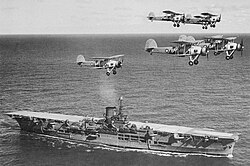| Ship | Aircraft | Displacement | Propulsion | Service |
|---|
| Laid down | Commissioned | Fate |
|---|
| HMS Colossus (R61) | 48 | 18,330 long tons (18,624 t) | 4 Admiralty 3-drum boilers, 2 shafts, Parsons geared turbines | 1 June 1942 | 16 December 1944 | Loaned to France as Arromanches from August 1946, then sold to France 1951 |
| HMS Glory (R62) | 48 | 18,330 long tons (18,624 t) | 4 Admiralty 3-drum boilers, 2 shafts, Parsons geared turbines | 27 August 1942 | 2 April 1945 | Scrapped 1961 |
| HMS Ocean (R68) | 48 | 18,330 long tons (18,624 t) | 4 Admiralty 3-drum boilers, 2 shafts, Parsons geared turbines | 8 November 1942 | 8 August 1945 | Scrapped 1962 |
| HMS Theseus (R64) | 48 | 18,330 long tons (18,624 t) | 4 Admiralty 3-drum boilers, 2 shafts, Parsons geared turbines | 6 January 1943 | 9 February 1946 | Scrapped 1962 |
| HMS Triumph (R16) | 48 | 18,330 long tons (18,624 t) | 4 Admiralty 3-drum boilers, 2 shafts, Parsons geared turbines | 27 January 1943 | 9 May 1946 | Scrapped 1981 in Spain |
| HMS Venerable (R63) | 48 | 18,330 long tons (18,624 t) | 4 Admiralty 3-drum boilers, 2 shafts, Parsons geared turbines | 3 December 1942 | 17 January 1945 | Sold to Netherlands 1948 and renamed Karel Doorman II then later sold in 1968 to Argentina as Veinticinco de Mayo. Scrapped 2000. |
| HMS Vengeance (R71) | 48 | 18,330 long tons (18,624 t) | 4 Admiralty 3-drum boilers, 2 shafts, Parsons geared turbines | 16 November 1942 | 15 January 1945 | Transferred to the Royal Australian Navy from 1953 to August 1955. Sold to Brazil as Minas Gerais December 1956. Scrapped 2004. |
HMS Warrior (R31)
ex-Brave | 48 | 18,330 long tons (18,624 t) | 4 Admiralty 3-drum boilers, 2 shafts, Parsons geared turbines | 12 December 1942 | November 1948 | Loaned to Royal Canadian Navy 1946-48 and not commissioned into RN until November 1948. Returned to UK 1956 and modernised. Sold to Argentina as Independencia 1958. |
HMS Perseus (R51)
ex-Ethalion
ex-Mars | 48 | 18,330 long tons (18,624 t) | 4 Admiralty 3-drum boilers, 2 shafts, Parsons geared turbines | 1 June 1942 | 19 October 1945 | Scrapped 1958 |
HMS Pioneer (R76)
ex-Edgar | 48 | 18,330 long tons (18,624 t) | 4 Admiralty 3-drum boilers, 2 shafts, Parsons geared turbines | 2 December 1942 | 8 February 1945 | Scrapped 1954 |














